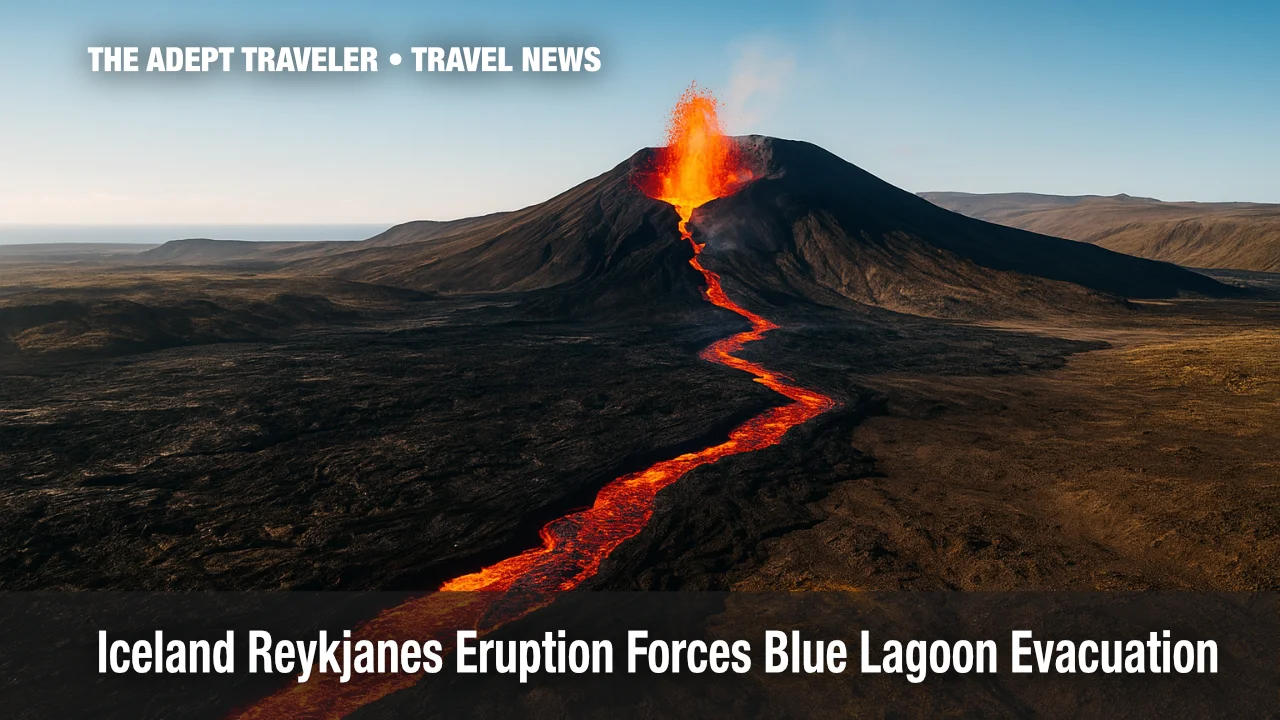Iceland Reykjanes Eruption Forces Blue Lagoon Evacuation

A modest but highly visible volcanic eruption lit up Iceland's Reykjanes Peninsula at 4 a.m. local time on July 16, 2025, sending glowing lava southeast from a fissure up to 0.62 miles long. Civil-protection teams moved fast, clearing Grindavík's evacuated town center, a nearby campground, and the luxury Blue Lagoon geothermal resort. Officials emphasize that no homes or critical infrastructure lie in the lava's path, and Keflavík International (KEF) continues normal operations. Even so, travelers headed to southwest Iceland should build in cushion time, carry N95 masks, and follow gas-pollution advisories.
Key Points
- Fissure opened near Sundhnúkur crater around 4 a.m.
- Lava flowing southeast, away from roads and utilities.
- Why it matters: Blue Lagoon and Grindavík remain closed until further notice.
- Keflavík Airport flights on schedule; no ash in upper atmosphere.
- Civil-defense urges visitors to check air-quality bulletins and heed barriers.
Snapshot
The Icelandic Meteorological Office (IMO) classifies the event as "relatively small," driven by magma that broke the surface after an overnight quake swarm. The fissure runs roughly 0.43-0.62 miles and vents steady lava rather than explosive ash, lowering aviation risk. Evacuations were precautionary; permanent residents left Grindavík in 2023, and security fences already ring the hazard zone. The famous Blue Lagoon resort posted a noon reopening goal but will reassess hourly. Travelers booked at the spa receive re-booking or refund options.
Background
Reykjanes lay dormant for eight centuries until seismic systems re-awakened in 2021. Today's outbreak marks the twelfth surface eruption and the ninth since December 2023. Iceland built earthen berms and lava-catchment walls after January's flows damaged pipes near Svartsengi power plant. While the new fissure sits north of those barriers, engineers continue 24-hour thermal-camera monitoring. Magma intrusions now follow a predictable pattern: quake swarm, rapid ground uplift, then short-lived fissure eruptions that vent mainly gases and fluid lava.
Latest Developments
Evacuations Completed Quickly
Police and search-and-rescue crews emptied Grindavík, the campground, and both Blue Lagoon hotels by 3 a.m., finishing in under an hour. Guest registries confirm full accountability, and no injuries are reported.
Air Travel Remains Stable
Isavia, Keflavík's operator, reaffirmed green status for arrivals and departures. The IMO has kept the aviation-color code at Orange-ongoing eruption with low ash production-but radar shows the plume topping out well below jet cruising altitude.
Gas Pollution Advisory
Southerly breezes push sulfur dioxide toward Reykjanesbær and potentially Reykjavík later today. Residents and visitors should limit outdoor exertion if the smell of matches becomes noticeable.
Analysis
For travelers, the biggest inconvenience is short-notice closure of headline attractions like the Blue Lagoon. Flexible itineraries mitigate disappointment: the peninsula still offers steaming mud pools, the Bridge Between Continents, and coastal hikes. Reykjavík sits 20 miles northeast on safe ground, making it a reliable base with plentiful hotel capacity. Tour operators typically reroute Golden Circle and South Coast day trips without penalty when eruptions occur. Insurance bought before July 15 should cover prepaid spa tickets; new policies may exclude known events. Pack an N95 or better respirator, keep eye drops handy, and arrange airport transfers via Flybus or rental car to avoid last-minute stress.
Final Thoughts
Iceland's civil-protection playbook worked: swift alerts, orderly evacuations, and minimal disruption to national infrastructure. Unless ash production spikes, flights should stay on time, and Reykjavík attractions remain open. Keep tabs on IMO updates, wear a mask if sulfur odors rise, and build slack into plans so the island's raw power enhances-rather than upends-your adventure in the land of fire and ice. Iceland volcano eruption
Sources
- Icelandic Meteorological Office - "An eruption has started on Sundhnúksgígaröð crater row" (July 16, 2025)
- Government of Iceland - "Volcanic Activity in Reykjanes" advisory (July 16, 2025)
- Keflavík Airport - "Flights operating normally after Reykjanes eruption" notice (July 16, 2025)
